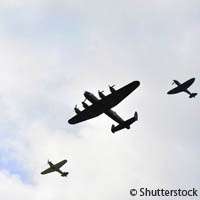Researchers fight to save recently uncovered German World War II bomber plane

Researchers from the United Kingdom are taking part in an attempt to rescue the last remaining intact World War II German light bomber Dornier Do 17, which has been submerged underwater in the English Channel since it was brought down in August 1940 during the height of the Battle of Britain.
The aircraft, which was commonly referred to as the 'Flying Pencil' (in German, Fliegender Bleistift), has lain protected from the corrosive effects of seawater under layers of sediment for the past 71 years, but shifting sands that uncovered the aircraft in 2010 have since left it exposed and unprotected. Now the aircraft-rescuing researchers, from Imperial College London and the Royal Air Force (RAF) Museum, face a race against the clock to save and preserve this rare Second World War II artefact before it corrodes any further.
Dr Mary Ryan, one of the researchers working on the project from Imperial College London, says: 'This is the last remaining intact Flying Pencil of its kind in the entire world, so the significance of this project to our history cannot be underestimated. We have been analysing fragments already brought to the surface and it is absolutely fascinating to see how this bomber, which crash landed more than 70 years ago, has been so well preserved by the layers of sand. We are relishing the challenge of finding a way to help save this historical treasure, so that it can be raised and put on display for future generations.'
Once the whole aircraft is retrieved the plan is to display it in a new wing of the RAF Museum that will be built to commemorate all those who lost their lives during the Battle of Britain. But the challenge for the team will be getting the conditions in the museum just right as too much humidity could result in condensation on the metal and lead to further corrosion.
Another major stumbling block the team will have to overcome is working out how to clean and remove corroded layers from the Flying Pencil's aluminium fuselage - these contain large amounts of the corrosive agent chloride which comes from the seawater. On small pieces of the wreckage that have already been raised to the surface the team are currently testing an environmentally friendly solution based on citric acid to remove surface layers of corrosion and sea deposits such as crustaceans.
The aim is to develop a solution that is both powerful enough to clean the bomber, as any remaining chloride on the metal surface could lead to further attacks of corrosion when the plane is on display, and at the same time sensitive to the plane's paintwork and markings so that the historical worth of the bomber is not lost.
It was at midday on 26 August 1940 when this particular Flying Pencil was brought down. As part of a large German formation en route to attack airfields in Essex, the plane was manned by four men and loaded with 2,000 lb of bombs. It was intercepted by RAF aircraft and sustained heavy damage, crashing into the sea off Goodwin Sands, a 10-mile-long sand bank in the English Channel, lying 6 miles off the English coast.
Records show that the pilot, Flight Sergeant Effmert, and another crew member, Sergeant Ritzel, managed to escape from the aircraft before going on to be held as prisoners of war. The other two crew members, Sergeant Reinhardt and Corporal Huhn, were killed when the plane came down. Their bodies were later recovered and laid to rest in military cemeteries.
Ian Thirsk, Head of Collections from the RAF Museum, comments on the human aspect of the aircraft's recovery: 'The recovery and conservation of this bomber will greatly enhance the RAF Museum's ability to tell the wider story of the Battle of Britain, particularly the sacrifices made on both sides during the conflict. At the moment, we are attempting to trace the relatives of the crew members who survived this fateful mission, in order to help engage visitors to the museum about the human story behind this episode of the war. As the last surviving example of the Dornier Do 17, this aircraft is truly unique.'
Once the researchers from Imperial College London have completed their work on how to best preserve the plane, a recovery team from the RAF Museum will use a lifting cradle to support the weight of the fragile aircraft as it is brought to the surface.
Provided by Imperial College London



















